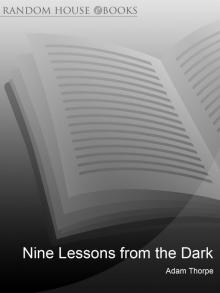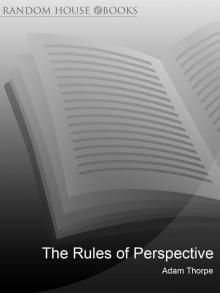- Home
- Adam Thorpe
Hodd Page 34
Hodd Read online
Page 34
372 Exodus 15.15: I have again adapted the translation from the Wycliffite Bible (Bod. 959) from c. 1382, as the least anachronistic: in using the vernacular, Hode appears to be anticipating Wycliffe and the Lollards, and their call for an English Bible, by well over a century and a half.
373 Most parish churches would not have been paved at this time.
374 This could well refer either to the suppression of the scholarly Amaurians in Paris early in the thirteenth century, or the burning in Strasbourg of adepts of the Free Spirit in about 1215. This particular heresy (noted previously) was singularly active again at the time of the writing of this account, at the beginning of the next century; thus our narrative was appropriately timed as an anti-heretical tract, if nothing else.
375 Boulogne.
376 ‘Forsothe al the puple herde voices, and siy… the hil smokynge; and thei weren afeerd, and shakun with inward drede…’ (Wycliffite Bible, Exodus, 20.18).
377 A well-known ‘telegraphic’ method based on the ancient Greek system of a five-by-five grid: 1-1 indicating A, 1-2 for B, 2-3 for M, 5-5 for Z, and so forth, with I and J combined. Our signallers used the same system on the Front, by means of the heliograph (an apparatus using mirrors and the sun), or the powerful Lucas lamp, particularly effective from pill-boxes in the Ypres area; or the exclamation mark of Very lights and rockets in emergencies.
378 Abbreviated from the Middle English word, ‘seken’ or ‘sechen’.
379 A common complaint from the thirteenth century on: the population stabilised at 6 million in 1300, remaining thus (with a dip after the 1349 Black Death) until the Industrial Age, when it rose sharply once more.
380 As in MS: this spelling of ‘Trick’ reminds us of Chaucer’s ‘tricherous’ (‘treacherous’) and ‘trechour’ (‘traitor’).
381 i.e. Christ.
382 A happily unbroken tradition in most of our rural public houses, which still boast their local songsters – often declaiming ancient ballads of inordinate length while being politely, if not reverently, listened to for the umpteenth time by the assembled drinkers: and long may this continue, for it is an essential link with the dim and unchronicled past of the English commoner.
383 As in MS. This is a remarkably close variation on the final lines of ‘Mirie it is, while sumer ilast’ (Bodleian MS, Rawlinson G. 22(14755), f. 11b), preserved by accident on a parchment used in the binding for another work. ‘Alas! How long is the night, and I, by very great wrong, sorrow and moan and vomit [or possibly ‘conjecture’].’ The last word, torn away in the flyleaf parchment, has usually been guessed at as ‘fast’; this extract suggests another possibility, rather more secular in tone: and also that the verses continue. It seems the song is already a familiar one at this date (1226).
384 i.e. of corn, continuing the traditional metaphor in an original way.
385 Food at this period was still eaten off platters of bread rather than plates, the meal taken with fingers from a shared bowl – ‘to common’ was to share one’s food with others and ayenward. The crust of bread was generally left for the animals.
386 The two have a complex and awkward relationship in the medieval mind.
387 For similar sightings of green folk, see, for example, Giraldus Cambrensis, Itin. Cambriae, or William of Newburgh’s twelfth-century chronicle.
388 I have nowhere found any mention of antipodean bells in Comestor’s book, La Mer des Histoires – a favourite of the Middle Ages. This whole passage is muddled, in comparison with the account of the green man himself, which will put some readers in mind of Poor Tom in King Lear, and yet others of young men known to them as having always borne a decent intelligence or wit (and even scholarship), who have lately returned mentally broken from the war, and are now hidden away where their spasticity, tremblings and meaningless prattle cannot disturb our ‘hundred years of peace’ wrought by those same worthy and pacific politicians recently so heralded for their bellicosity and belligerence. [Marginal emphasis by FB against last three lines, with ‘All is hogswash!’ scrawled in pencil.]
389 I might say that at least in my rustic English village, which has as yet no mains drainage, piped water or gas, or electrical and telephone lines, this countryman’s practice is still widespread; the less charitable claim that you can smell our settlement from two valleys away, as no doubt you could have done seven centuries ago.
390 Pieces of dung.
391 The copyist appears to have slipped and repeated a line, and again with ‘narrow mouth’.
392 A recent theory assigns the medieval tendency for vivid, waking visions to an intoxicating substance found in bread left too long in damp conditions.
393 The actual infectiousness of leprosy was exaggerated by the medieval mind, in contrast to its lax or ignorant attitude to far more virulent maladies. The remarkable St Hugh of Lincoln was canonised mainly as a result of freely kissing leper victims.
394 The original motive of his misdeed was in fact the drowning incident. [Scrawled in FB’s hand halfway down the right-hand margin against the main body of the proofs’ text: ‘end of the bloody Fatigue – back to the bloody line hey ho’.]
395 This incident tallies closely with the well-known story told by the chronicler Roger of Wendover, that took place in 1209 and was the starting point of Cambridge as a proper university: following the execution of their three fellows, all the clerks left the city in protest, ‘leaving Oxford entirely empty’, to the benefit of Cambridge. However, there is no mention of any witchcraft in the original story, the murdered woman being killed ‘by chance’. Also, if 1209 is an accurate date, then the hermit must have arrived almost immediately in the village, as a fugitive clerk rather than a wandering minstrel-monk. It is possible that our author has confused the two stories, or deliberately ‘borrowed’ from the more familiar one, in a way that is typical of medieval practice.
396 Spent with wandering.
397 L. fossilia: originally, a ‘fossil’ was anything non-metal dug out of the earth. Clearly, this one is an ammonite, in which the area abounds, and they are still sold as ‘snake stones’, to holidaymakers, in honour of a later ‘popular’ tradition maintaining them to have been a plague of snakes petrified by St Hilda of Whitby (c. 614?680).
398 As in MS: dogs found to be pursuing game secretly were mutilated by cutting off a foot. From Anglo-Saxon hamelian, to mutilate.
399 The First Crusade founded the Christian kingdom at Jerusalem in 1099, lost it to Saladin in 1187, and after two brief spells of Christian rule, lost it for good in 1244, from which date it remained in Mohammedan hands until four years ago (1917).
400 Presumably ridiculous only because of its wearer.
401 This may have been the effect of heat, or simple rigor mortis, rather than pain: I have had personal experience of such startling changes in the faces and members of dead comrades, due to the passing of time (even mere hours) or abrupt shifts in temperature from, say, cosy dug-out to frozen trench.
402 A muddled reference to the storming of the Cathar-held city of Béziers, where much of the captured population claimed to be Catholic; according to Caesarius of Heisterbach in his Dialogus Miraculorum (c.1220–35), what Arnold actually said was: ‘Slay them, for God knoweth His own.’ Whereupon some 20,000 inhabitants of all ages, whether orthodox or heretic, were put to the sword. Pope Innocent III heartily congratulated him on this ecumenical and time-saving ‘extermination’. [Marginal note in FB’s hand: ‘And so the padre congratulated B Company.’]
403 This being a large iron hook, rather than a fisherman’s.
404 The twelfth and thirteenth centuries saw the greatest period of cathedral-expansion, the colossal buildings’ towers being the highest man-made constructions on the known earth at that time. This passage, despite its religious zeal, has a certain queasy resonance for those born into the age of Messrs Darwin, Nietzsche, Marx et al. – and especially for those who had a chance recently to experience primaeval slime at first hand in present-day France and Belgium
, into which ooze a living man could vanish within seconds.
405 This is all the more interesting because, in the opinion of some folk historians, it was the very popularity of the Robin Hood ballads in the following (fifteenth and sixteenth) centuries that ensured the survival of the ballad form into our own day, however debased it has now become.
406 ‘For his eldere son was in the feeld; and whanne he cam, and neiyede to the hows, he herde a symfonye and a croude [fiddle].’ (Wycliffite Bible, Luke 15.25).
407 Hopefully up-river of the kitchen and the monks’ latrine or reredorter, though this is by no means certain: sanitary considerations being as little regarded then, through ignorance, as in the late glistening slime of Flanders, through circumstance.
408 Which will be at 2 a.m. The parchment here is damaged by white-hot shrapnel burning it upon the verso side, some of the burns being severe enough to have penetrated the leaf, obscuring a few words on the recto. The photogravure opposite, showing a lady with exaggerated eyes peeping at the viewer over a cloth that covers her mouth, is of the somewhat crude but delightful drawing that appears in the MS, a few inches below its last line. Resembling English work of the late thirteenth or early fourteenth century, we can assume it was copied from the original by the conscientious scrivener – to whom our general gratitude, of course, must be wholesale and never-ending. [This footnote crossed out by FB, with a pencilled scrawl in the margin: ‘withdraw to safety, Alec – bolt – for Godssake – leg it –’]

 Missing Fay
Missing Fay Hodd
Hodd Pieces of Light
Pieces of Light The Standing Pool
The Standing Pool Ulverton
Ulverton Nine Lessons From the Dark
Nine Lessons From the Dark Flight
Flight The Rules of Perspective
The Rules of Perspective From the Neanderthal
From the Neanderthal Is This the Way You Said?
Is This the Way You Said? Still
Still No Telling
No Telling Voluntary
Voluntary Between Each Breath
Between Each Breath